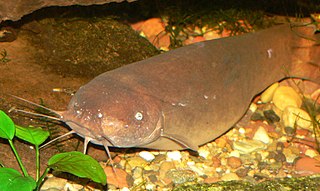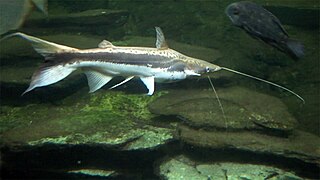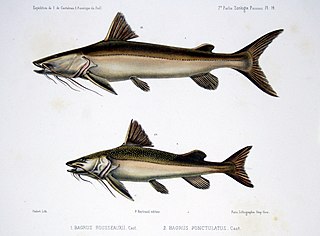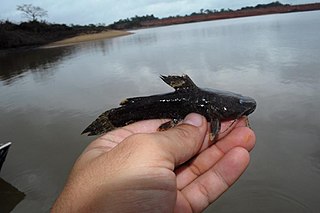
Candiru, also known as cañero, toothpick fish, or vampire fish, is a species of parasitic freshwater catfish in the family Trichomycteridae native to the Amazon Basin where it is found in the countries of Bolivia, Brazil, Colombia, Ecuador, and Peru.

The Amblycipitidae are a family of catfishes, commonly known as torrent catfishes. It includes three genera, Amblyceps, Liobagrus, and Xiurenbagrus, and about 36 species.

Trichomycteridae is a family of catfishes commonly known as pencil catfishes or parasitic catfishes. This family includes the candiru fish, feared by some people for its alleged habit of entering into the urethra of humans. They are one of the few parasitic chordates. Another species is the life monsefuano which was important to the Moche culture and still an important part of Peruvian cuisine.

The Aspredinidae are a small South American family of catfishes also known as the banjo catfishes, with about 43 species.

The stream catfishes comprise the family Akysidae of catfishes.

Malapterurus is a genus of catfishes of the electric catfish family (Malapteruridae). It includes 18 species.

Sorubim is a small genus of long-whiskered catfish native to tropical South America. A number of characteristics allows the differentiation of each species in the genus. Sorubim species are important food fish in South America and are highly significant to fisheries of some areas; however, harvests of these fish are not identified as much as other, more popular food fishes such as Colossoma, Arapaima, and Brachyplatystoma. Some species of this family are popular aquarium fish.

Brachyplatystoma is a genus of catfish from the family Pimelodidae. As the occasionally used common name goliath catfishes indicates, this genus includes some of the largest species of catfish, including the piraíba, B. filamentosum, which reaches up to the region of 3.6 metres (12 ft) in length. Brachyplatystoma are found in the Amazon and Orinoco basins, and other tropical freshwater and brackish habitats in South America. Some species are migratory. These fish are important as food fish and, to some extent, aquarium fish.

Batrochoglanis is a small genus of catfishes of the family Pseudopimelodidae.

Leiarius is a genus of long-whiskered catfishes native to South America. Most of the genus' species are found in the aquarium hobby as ornamental fish.
Paracanthopoma parva is a species of catfishes of the family Trichomycteridae. P. parva grows to about 2.7 centimetres (1.1 in) SL and is endemic to Brazil where it occurs in the Amazon and Essequibo River basins.
Tridensimilis is a genus of pencil catfishes native to South America.
Stegophilus is a genus of pencil catfishes native to South America.
The Vandelliinae are a subfamily of catfishes of the family Trichomycteridae. Vandelliines are hematophagous, feeding on the blood of larger fish. Members of this subfamily may be known as candirú, notorious for occasionally entering human bodily orifices, particularly the urethra; no evidence indicates such attacks are anything more than rare and accidental perversions of the usual feeding behaviour of the parasite — it seems unlikely that it would survive in the human body for long, so such an entry should be disastrous for both parties. In the usual course of events, parasitic vandelliines enter the body cavities of host fishes, feed on blood from gill filaments, and leave again.

Cetopsis is a genus of catfishes of the family Cetopsidae.

Entomocorus is a genus of catfishes of the family Auchenipteridae.

Cetopsis candiru, also known as candiru, candiru açú, candiru cobra or canero, is a carnivorous species of whale catfish found in the Amazon basin of Peru, Brazil and Bolivia. Similar to Cetopsis coecutiens, Cetopsis candiru is a large species of the genus Cetopsis and a widespread scavenger, known for its voracious feeding and the habit of burrowing into the carcasses of dead animals and humans. Despite its name, it is not closely related to the bloodsucking Candiru.
Brachyplatystoma filamentosum, commonly called piraíba, kumakuma, or lau lau, is a species of large catfish of the family Pimelodidae and genus Brachyplatystoma that is native to Amazon and Orinoco River basins and rivers in Guianas and northeastern Brazil.
The Highwaterman catfish, is a species of pelagic potamodromous catfish of the family Pimelodidae that is native to Guyana, Suriname, Venezuela, northern Brazil and Gulf of Paria.
Hypophthalmus marginatus, commonly called the Mapará, is a species of demersal potamodromous catfish of the family Pimelodidae that is native to Amazon and Orinoco River basins of Brazil, Peru and major rivers of French Guiana and Suriname.












